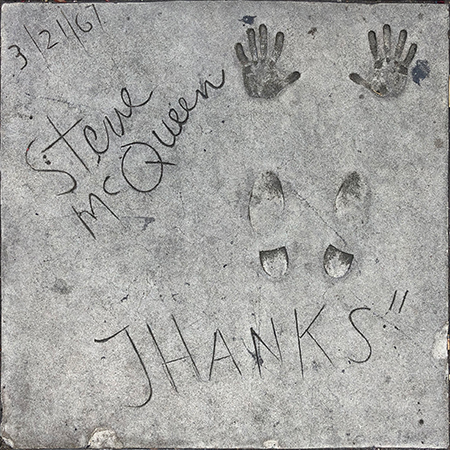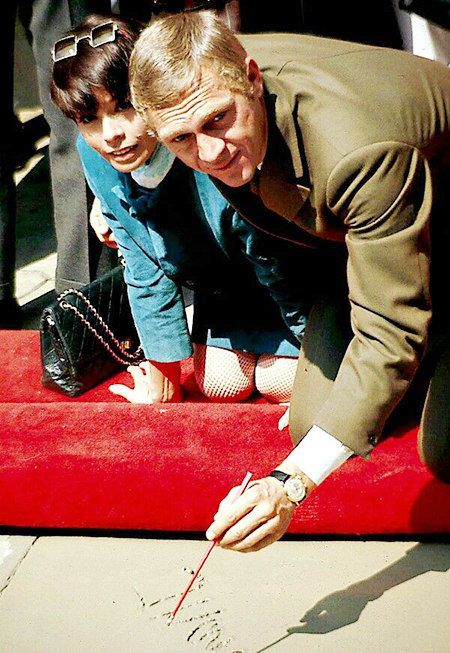 |
 |
|
|
| Steve McQueen |
 |
| Forecourt Ceremony held on Tuesday, March 21, 1967 |
| |
Born: Terrence Steven McQueen, March 24, 1930, in Beech Grove, Indiana
Age at the time of the ceremony: 36
Died: November 7, 1980, in Ciudad Juárez, Chihuahua, Mexico, age 50
|
| |
Steve McQueen, as "The King of Cool" embodied the anti-hero counterculture mood of the 1960s. After a very fast rise, McQueen became one of the most popular stars in the world.
McQueen's father was a circus barnstorming flyer, who left his mother Julia after only six months. Unable to handle motherhood, Steve grew up with his grandparents in Slater Missouri, then in 1933, they all moved in with Uncle Claude on his nearby farm. Steve became a good Catholic boy. Uncle Claude gave Steve a red bicycle for his fourth birthday, launching a lifelong obsession with speed and auto racing.
Moving to Indianapolis
to live with mother Julia and a stepfather who beat him, Steve left home at age nine, and began running with a street gang. He was sent back to live with Uncle Claude. Meanwhile, Julia divorced and married again, asking Steve to be sent to live with her in Los Angeles.
The new stepfather and young Steve fought — physically — immediately. Sent back to Uncle Claude, Steve ran away to join a circus at age 14, then drifted back to Julia in Los Angeles. Caught stealing hubcaps, stepdad threw the miscreant down the stairs. Steve vowed to kill the man if he laid hands on him again. He was sent to a state-run boys home, where he began to mature some. After becoming famous, McQueen would return to the home to talk to the boys.
At age 16, he joined the Merchant Marines, but abandoned ship in the Dominican Republic, becoming a bouncher in a whorehouse. Eventually finding his way back to Texas, he drifted through a series of jobs. In 1947, he joined the Marine Corps. After going AWOL, he spent 41 days in the brig, during which time he decided to embrace the USMC code of discipline. He saved the lives of five Marines during an exercise, and worked in the honor guard on president Harry Truman's yacht.
Studying acting in New York on the GI Bill, McQueen studied with Stella Adler. He also began to race motorcycles out on Long Island. He made his Broadway debut in A Hatful of Rain, taking over the lead role of Johnny Pope when Ben Gazarra left the show in June 1956.
Moving to Hollywood, McQueen married fellow thesp Nelie Adams. Nelie's had a manager, Hilly Elkins, who got McQueen some gigs in "B" movies. McQueen made his film debut as an
extra on the cheap girlie movie Girl on the Run (released in December 1953), and had a bit part in director Robert Wise's Somebody Up There Likes Me (released in July 1956) with Paul Newman.
McQueen did a lot of television work, appearing on shows such as West Point in 1957, The Big Story in 1957, Climax! in 1958, Tales of Wells Fargo in 1958, Trackdown in 1958 and so on. Trackdown star and co-motorcycle racer Robert Culp taught McQueen how to do the "fast draw" with a sawed-off shotgun for his role as a bounty hunter. The character worked so well that McQueen got his own show: Wanted: Dead or Alive for 94 episodes, airing over CBS, from September 1958 to March 1961. Right when Wanted: Dead or Alive went on the air, Steve's kinda-dumb, kinda-not sci-fi movie The Blob (released in September 1958) came out, making him a star in two mediums.
A low-budget caper film The St. Louis Bank Robbery (released in September 1959), was already in the can, but Frank Sinatra put Steve in a co-starring role in Never So Few (released in December 1959), working with director John Sturges for the first time. Sturges cast McQueen in his western The Magnificent Seven (released in November 1960), with the result that Yul Brynner, would come to resent what he felt was McQueen's attempts to upstage him. Their director let him. You decide.
After the World War II film Hell is for Heroes (released in June 1962), with Bobby Darrin, Sturges placed McQueen front and center in his epic prison camp movie The Great Escape (released in July 1963), with James Garner. McQueen's character as the "Cooler King" plus his escape from the camp on a motorcycle cemented his cinematic image for all time.
He co-starred in what has to be the earliest depiction of a one night stand in a Hollywood film, Love with the Proper Stranger (released in December 1963), with Natalie Wood, and played a character very close to his real one in Baby the Rain Must Fall (released in January 1965), with Lee Remick; both films for director Robert Mulligan.
Director Norman Jewison cast McQueen in his film about professional poker players, The Cincinnati Kid (released in October 1965), with Ann-Margaret, while Nevada Smith (released in May 1966), with Karl Malden, became his first western after breaking through with Magnificent Seven. Re-teaming with director Robert Wise, MacQueen starred in his epic The Sand Pepples (released in December 1966), with Richard Attenborough.
Invited to place his footprints in the Forecourt at Grauman's Chinese, McQueen typically demanded that his block be oriented 180 degrees from all the others; they all face the theatre, while McQueen's faces Hollywood Bovevard. This and Ali MacGraw's are the only ones to run contrary to all the others.
McQueen starred with Faye Dunaway in The Thomas Crown Affair (which played the Chinese in June 1968), then starred in a signature film for him, the police procedural, Bullitt (released in October, 1968), with Robert Vaughn. In a complete turn-about, McQueen starred in a comic William Faulkner story, The Reivers (released in December 1969).
Le Mans (released in June 1971), allowed McQueen to finally make a picture about racecar driving, while Junior Bonner (which played the Chinese in June 1972), with Robert Preston, is perhaps the most mellow film director Sam Peckinpah ever made — curious, isn't it?
McQueen's next, The Getaway (released in December 1972), is significant, since McQueen divorced his wife Nelie, in order to marry his co-star Ali MacGaw (they too, would divorce in 1978). Papillon (released in December 1973), with Dustin Hoffman, is perhaps the most conventional period film McQueen starred in, unless you can view The Towering Inferno (released in December 1974), with Paul Newman, as a contemporary film. . . McQueen was paid a pretty penny to appear in the film, which seems to allowed him to take a break from the silver screen.
When he emerged from his revery, he decided to make a film of Danish playwright Henrik Ibsen's An Enemy of the People (released in March 1978), with Bibi Andresson. The low-budget picture was hardly released in the US, but Warner Bros. forgave McQueen Enemy with his starring in a western about the legendary Tom Horn (released in March 1980) with Linda Evans, which did well.
The Hunter (which played the Chinese in August 1980) with Eli Wallach, was McQueen's final film. Having divorced Ali MacGraw in 1978, McQueen married fashion model Barbara Minty in 1980. McQueen had developed a bad cough in 1978, causing the star to give up smoking. Later, it was thought that McQueen had mesothelioma from his exposure to asbestos while in the Marines.
With his cancer spreading, McQueen turned himself over to the care of William Donald Kelley, whose unorthodox treatment is still controversial today. McQueen had a large tumor on his abdomen, which he attempted to have removed in Mexico. Twelve hours after the surgery, he died of cardiac arrest, on
November 7, 1980 at the age of 50. Steve McQueen — The Last Mile, by Barbara McQueen was published in 2006. |
|
|
|
|
| |
 |
 |
| Grauman's Chinese Theatre, Hollywood, California. Steve McQueen Forecourt block. Executed by John Tartaglia, Tuesday, March 21, 1967. 48 x 48 inches. |
 |
 |
 |
| Grauman's Chinese Theatre, Hollywood, California. Steve McQueen Forecourt ceremony, Tuesday, March 21, 1966. Wife Nelie and Steve McQueen give the camera a look after he has signed his name in the cement. |
|
 |
| |
 |
| |
|